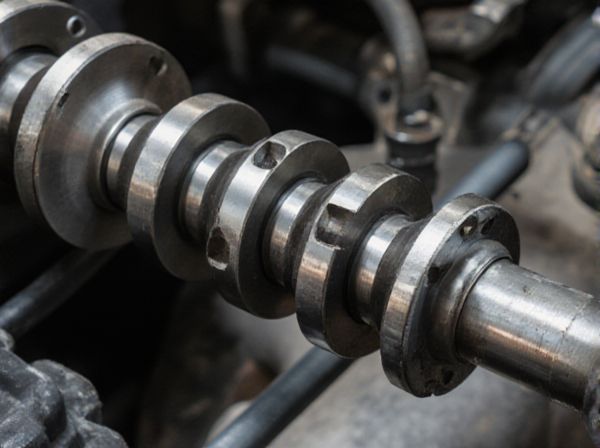
Photo illustration: Reverse Rotation Camshaft vs Standard Rotation Camshaft
A reverse rotation camshaft rotates opposite to the standard camshaft direction, requiring specific engine components designed to accommodate this change for proper timing and valve operation. Your engine's performance and compatibility depend on selecting the correct camshaft rotation to ensure smooth operation and prevent mechanical failures. In racing and custom applications, reverse rotation camshafts are used to achieve unique timing curves and improve engine efficiency under certain conditions.
Table of Comparison
| Feature | Reverse Rotation Camshaft | Standard Rotation Camshaft |
|---|---|---|
| Rotation Direction | Opposite to engine crankshaft | Same as engine crankshaft |
| Application | Specialty engines, marine, or custom setups | Most gasoline and diesel engines |
| Valve Timing | Reversed; requires cam profile adjustment | Standard valve timing profile |
| Compatibility | Limited; custom or specific engine designs | Widely compatible with OEM engines |
| Performance Impact | Optimized for reverse rotation setups | Optimized for conventional engine operation |
| Cost | Higher due to specialized machining | Standard manufacturing cost |
Introduction to Camshaft Rotation
Camshaft rotation is a critical aspect of engine timing that determines the direction the camshaft turns relative to the crankshaft. Standard rotation camshafts typically rotate clockwise in most internal combustion engines, facilitating the opening and closing of valves in sync with piston movement. Reverse rotation camshafts, rotating counterclockwise, are designed for specialized applications such as certain performance engines and diesel applications, requiring precise valve timing adjustments to optimize power and efficiency.
What Is a Reverse Rotation Camshaft?
A reverse rotation camshaft rotates in the opposite direction of a standard rotation camshaft, typically used in marine and industrial engines to accommodate specific engine layouts or accessory drives. This design allows engines to operate efficiently with counter-rotating propellers or configurations where reverse engine rotation is required for optimal performance. Reverse rotation camshafts have differently oriented timing and valve events compared to standard camshafts, making them essential for applications demanding reversed crankshaft rotation.
Understanding Standard Rotation Camshafts
Standard rotation camshafts rotate clockwise when viewed from the timing gear end, aligning with the engine's normal rotational direction. This configuration ensures proper valve timing and optimal engine performance, as it is designed to work with the intake and exhaust stroke sequences. Standard rotation camshafts are widely used in most internal combustion engines, providing reliable and predictable valve operation.
Key Differences: Reverse vs Standard Rotation
Reverse rotation camshafts rotate counterclockwise, opposite to standard rotation camshafts, which turn clockwise as seen from the front of the engine. This key difference affects valve timing and engine design, requiring specific ignition timing and oil pump configurations for reverse rotation setups. Reverse rotation camshafts are typically used in specialized applications such as certain aircraft engines and custom motorcycle builds to counteract torque effects.
Applications for Reverse Rotation Camshafts
Reverse rotation camshafts are primarily used in applications where the engine's rotation direction opposes standard configurations, such as in certain marine engines, snowmobiles, and race cars with specialized drivetrain layouts. These camshafts optimize valve timing for engines that rotate counterclockwise, ensuring precise intake and exhaust cycles to enhance performance and reliability. Their design allows for compatibility with reverse rotation crankshafts, supporting applications requiring unique rotational dynamics in powertrain systems.
Benefits of Standard Rotation Camshafts
Standard rotation camshafts provide reliable timing synchronization with the engine's crankshaft, ensuring consistent valve operation and optimal combustion efficiency. These camshafts are widely supported in terms of aftermarket parts and tuning options, simplifying maintenance and performance upgrades. Engine designs incorporating standard rotation cams typically benefit from proven durability and compatibility with OEM components, reducing the risk of mechanical failures.
Performance Impact: Which Rotation Is Better?
Reverse rotation camshafts generate valve timing optimized for engines with opposite crankshaft rotation, improving performance in specific applications like marine or industrial engines. Standard rotation camshafts suit conventional engines, delivering consistent power and efficiency in typical automotive use. Performance improvements depend on engine design and application, with no universal "better" rotation; matching camshaft rotation to engine specs ensures optimal valve timing and power output.
Engine Compatibility Considerations
Reverse rotation camshafts require engines specifically designed or modified for opposite crankshaft rotation, affecting timing components and oil pump orientation. Standard rotation camshafts are compatible with the majority of internal combustion engines operating on conventional clockwise crankshaft rotation. Proper engine compatibility ensures optimal valve timing, lubrication, and overall performance, preventing potential mechanical failures.
Installation and Maintenance Tips
Reverse rotation camshafts require customized timing components and specialized installation procedures due to their opposite rotation direction compared to standard rotation camshafts. Proper alignment of timing marks and use of compatible chain or belt drives are crucial to prevent engine timing issues and ensure optimal performance. Regular inspection for wear on sprockets and chain tension, along with adherence to torque specifications, enhances the longevity and reliability of reverse rotation camshaft setups.
Choosing the Right Camshaft for Your Engine
Selecting the right camshaft for your engine depends on understanding the specific rotation type required--reverse rotation camshafts are designed for engines that rotate counterclockwise, commonly found in marine or custom applications, while standard rotation camshafts suit most automotive engines rotating clockwise. Matching the camshaft to your engine's rotation ensures proper valve timing, optimal performance, and engine longevity. Factors such as engine configuration, intended use, and manufacturer specifications must be considered when choosing between reverse and standard rotation camshafts.
 caratoz.com
caratoz.com